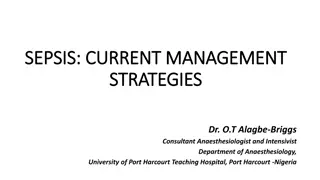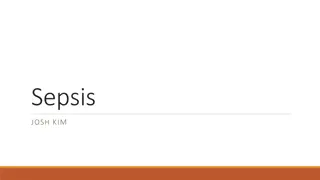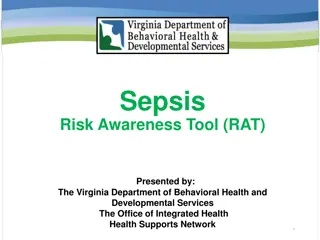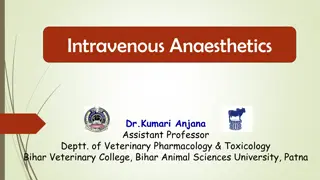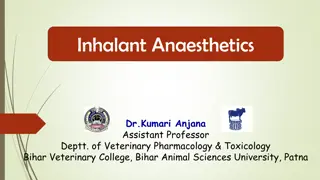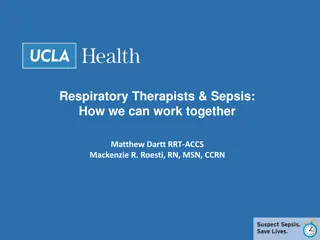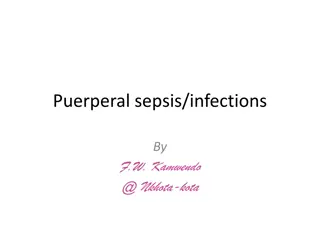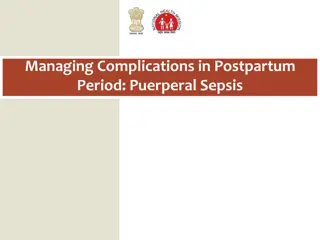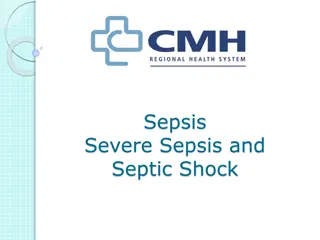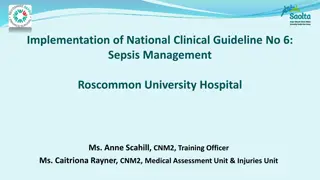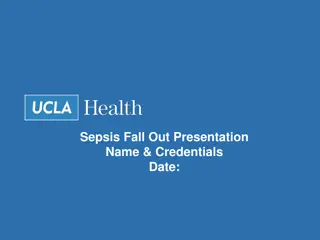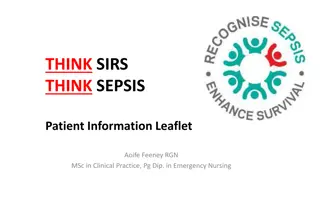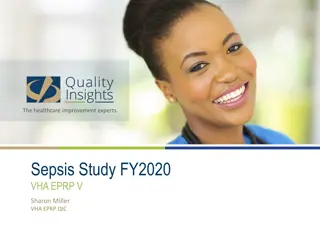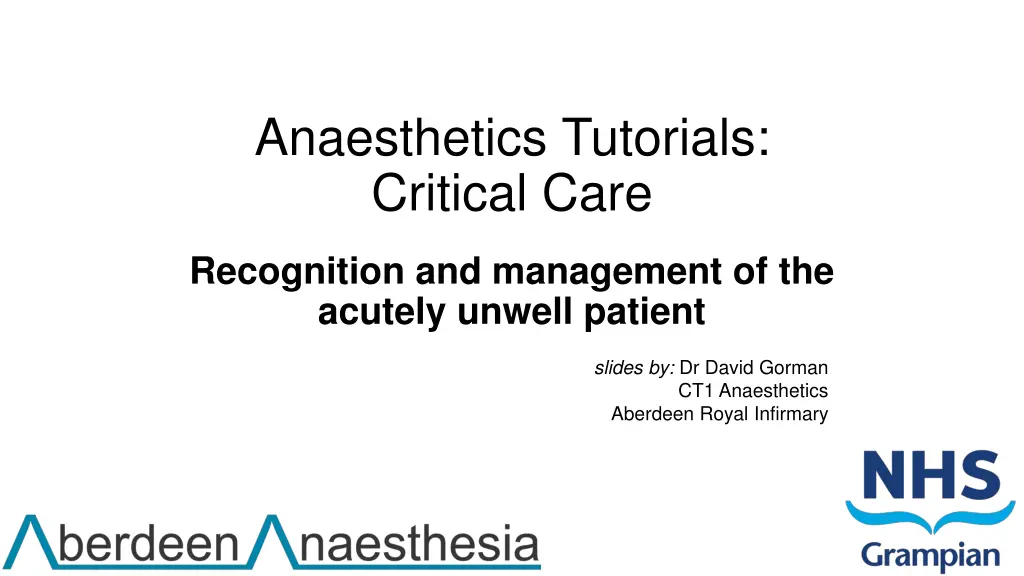
Recognizing & Managing Acutely Unwell Patients in Critical Care
Learn about critical care management for acutely unwell patients in this tutorial by Dr. David Gorman. Topics covered include initial sepsis management, rational fluid and antibiotic use, principles of hypovolaemia, and when to refer to critical care services.
Download Presentation

Please find below an Image/Link to download the presentation.
The content on the website is provided AS IS for your information and personal use only. It may not be sold, licensed, or shared on other websites without obtaining consent from the author. If you encounter any issues during the download, it is possible that the publisher has removed the file from their server.
You are allowed to download the files provided on this website for personal or commercial use, subject to the condition that they are used lawfully. All files are the property of their respective owners.
The content on the website is provided AS IS for your information and personal use only. It may not be sold, licensed, or shared on other websites without obtaining consent from the author.
E N D
Presentation Transcript
Anaesthetics Tutorials: Critical Care Recognition and management of the acutely unwell patient slides by: Dr David Gorman CT1 Anaesthetics Aberdeen Royal Infirmary
Learning objectives By the end of this session, you should be able to: Recognise the acutely unwell patient Initiate initial management of sepsis Describe rational fluid and antibiotic management Explain basic principles of hypovolaemia in sepsis and septic shock Understand when and how to refer to critical care services
The patient Mrs A is 68 years old and is recovering in hospital from a fall at home She tripped and fell over her cat at home, sustaining a pubic ramus fracture which has been conservatively managed. She is currently awaiting an occupational therapy assessment to ensure she is safe for discharge with her current supports. PMHx: Hypertension GORD Osteoarthritis Chronic low back and left hip pain Drug Hx: Candesartan 5mg od Omeprazole 20mg od Paracetamol 1g qds Tramadol 50mg prn Social Hx: lives alone, normally independent, little family support. Ex-smoker, occasional alcohol. Sometimes uses a walking stick.
Ward concerns You are the FY1 covering the medical rehabilitation ward. Nursing staff on the ward are concerned that Mrs A is complaining of some dysuria, has been incontinent and her urine smells foul . She seems otherwise well. What would you do next?
A-E assessment A- maintaining own B- RR 12, sats 99% on room air. Talking in full sentences. No evident accessory muscle use. Chest: good air entry throughout, faint bibasal wheeze but otherwise clear C- Warm and well perfused. Pulse 67, regular. BP 115/76. Heart sounds normal, no murmurs D- alert, oriented to time/place/person. BGL 6.7 E- looks well. Abdomen soft, mild suprapubic tenderness. No rashes. Temp 36.7. What is the likely diagnosis? What would you do next?
Next steps Urine dipstick shows +ve nitrites, leukocytes and micro- haematuria. What is the diagnosis? Can it be managed safely on the ward? What laboratory investigations, if any, would you arrange?
Investigations You also send off a midstream urine culture, but results will take at least 24 hours Do these blood results alter your management? What are you going to do next? Are there local resources to help guide you?
Next steps You prescribe Trimethoprim 200mg twice daily, in line with the antibiotic guidelines Who should be informed about the change in Mrs A s condition?
Next steps You telephone your registrar to inform them of developments and check they are happy with the plan This ensures that your senior is aware of the changes, and flags Mrs A for review on the next ward round.
The next day The following morning, you are called to see Mrs A The nurses are concerned she is becoming more unwell.
97100 100 100 97 97 99 100 99 100 100 97 What do you think about these observations? What would you do next? A A A A A A A A A A A A
A-E A- maintaining own, speaking B- RR 17, sats 100 on air. Mild increased work of breathing. Full sentences. Chest clear C- cool at peripheries, cap refill 3s. Pulse 110, BP 95/60. HS normal D- disoriented in time and place E- abdomen soft, suprapubic tenderness and wet soiled bedsheets. No rashes. Temp 38.5 What is the likely diagnosis?
Sepsis Sepsis is a clinical diagnosis when there is confirmed or suspected infection and at evidence of systemic dysfunction. Sepsis is a medical emergency! Historically, this has been diagnosed using SIRS criteria : RR > 20, or pCO2 < 4.3 HR > 90 SBP < 90 Temp > 38 or < 36 WCC > 12 or < 4 New confusion or drowsiness BGL > 7.7 (if not diabetic) Recently, qSOFA is an alternative way to screen for sepsis: RR 22 or greater Altered mentation / GCS < 15 SBP < 100
Initial steps Given the clinical presentation, what is the likely source? What are other common possible sources? What antibiotics should you give, and by what route? Where would you find advice? Mrs A is tachycardic and hypotensive. How should you treat this?
Local antibiotic guidance The Sepsis Six
Managing sepsis Sepsis six - Give three, take three For Mrs A: GIVE IV antibiotics ASAP, according to empirical policy OR sensitivities if they are available You ll need to prescribe IV antibiotics oral trimethoprim is no longer appropriate Why do you think her UTI has progressed to sepsis? She is hypotensive Why? How are you going to treat this? She s not hypoxic, so we don t need oxygen right now remember sepsis can increase O2 requirements so this may change Take blood cultures (urine culture is pending) Take bloods including a VBG to measure metabolic state and lactate Hourly monitoring of vital signs and fluid balance Urinary catheters are no longer recommended for the sole purpose of output monitoring; use your clinical judgement whether one is needed GIVE fluid resuscitation GIVE oxygen if required TAKE cultures: blood and other relevant, eg urine or sputum but do not delay antibiotics to do so TAKE biochemistry including lactate TAKE regular urine output and vital signs monitoring
Results VBG: Microbiology: pH 7.23 pO2 9.4 pCO2 3.9 Na 136 K 4.0 Ca 2.0 HCO3 17 Glu 9.5 Lac 4.1 Urine (mid-stream): Microscopy: elevated count of pus cells and microhaematuria Culture: Escheria coli significant growth Sensitivities Trimethoprim Nitrofurantoin Amoxicillin Gentamicin Ciprofloxacin Culture ongoing. R S R S S Lab bloods are pending you might expect a raised white cell count, CRP and possibly evidence of end organ dysfunction
Mrs A So, for Mrs A, you: Summon senior help Take blood cultures (and repeat urine if indicated) Send blood for FBC, U+Es, LFTs, CRP and lactate Consider a venous blood gas (or arterial if hypoxic) to rapidly check biochemistry and lactate Commence IV antibiotics immediately based on local guidance Commence fluid resuscitation The next slides will focus on the fluid management.
Fluid resuscitation in sepsis The inflammatory response seen in sepsis causes inappropriate systemic vasodilatation, resulting in relative hypovolaemia which if untreated can progress to septic shock Sepsis also increases basal fluid requirements increased metabolic rate, insensible losses from hyperthermia and increased respiratory rate Treating sepsis requires IV fluid resuscitation continuing oral fluids, or IV fluids at a maintenance rate is not appropriate Remember to review the patient s drug therapy and withhold any medications which might complicate Mrs A s condition (can you think of any?)
The fluid challenge Septic patients usually require and initial fluid bolus to fill their intravascular space and improve their hypotension How much fluid would you give for a fluid challenge in Mrs A? How might this amount differ between patients, e.g those with heart failure? What fluids are appropriate and not appropriate for fluid resuscitation?
Fluid resuscitation Appropriate fluids include: Plasmalyte-148 Hartmann s solution Blood and blood products (if shock is due to haemorrhage) Commonly prescribed fluids that are inappropriate for fluid resuscitation: 0.18% NaCl + 4% glucose ANY glucose/dextrose solution Fluids with drugs added Fluids such as 0.9% NaCl and PL148 are isotonic, so help to expand the intravascular space before they redistribute. Fasting fluids and low-concentration glucose are hypotonic, so redistribute before they fill the intravascular space and can rapidly cause hyponatraemia if given too quickly.
Fluid challenge You prescribe Mrs A a 500ml bolus of Plasmalyte-148 The nurses give this via a pump at 999ml/hr (the fastest it will go) They repeat her obs straight afterwards The effect on her observations is shown. What can you see? 97100 100 100 97 97 99 100 99 100 100 97 100 100 A A A A A A A A A A A A
Fluid challenge You discuss with your senior and it is felt that it is appropriate to repeat fluid boluses to treat hypotension, as Mrs A has good cardiac function 97100 100 100 97 97 99 100 99 100 100 97 10097 100 100 100 98 A A A A A A A A A A A A What can you see on the observation chart? What else might guide your fluid resuscitation?
Fluid resuscitation The amount of fluid given should be guided by the haemodynamic response as well as: Urine output (an indirect measure of organ perfusion) Serum lactate (serial blood gases are useful) If stability is achieved after a fluid bolus, IV fluid resuscitation should be continued at a slower rate to reflect the increased requirements and ongoing relative hypovolaemia Usually, this would mean e.g Hartmann s or plasmalyte-148 at 125-500ml/hr, depending on the patient s fluid status and co-morbidities Many sources advise a total fluid target of 30ml/kg for initial fluid resuscitation in sepsis for a 70kg adult this equates to 2.1L so 2L is often used as an approximation
97100 100 100 97 97 99 100 99 100 100 97 10097 100 100 100 98 Mrs A has now had 2L of IV crystalloid (in this case PL148), given in 500ml boluses Mrs A s chart demonstrates an initial improvement but now ongoing hypotension and tachycardia Her urine output is noted to be minimal This likely represents septic shock A A A A A A A A A A A A
Septic shock Broadly, shock (of any cause) is defined as acute circulatory failure with resultant inadequate oxygen delivery to tissues Causes include hypovolaemic (e.g haemorrhage), septic (relative hypovolaemia), cardiogenic (e.g post MI) and neurogenic (e.g post spinal cord injury) Septic shock is defined as: a subset of sepsis where particularly profound circulatory, cellular and metabolic abnormalities substantially increase mortality. Septic shock should be suspected when the patient remains hypotensive (or otherwise inadequately perfused, e.g poor urine output) despite adequate fluid resuscitation
Management of septic shock Inadequate fluid response after high-volume (>2L) fluid resuscitation, or other suspicion of septic shock, indicates referral to critical care Who might you call for further advice and management? Can this be managed on Mrs A s current ward?
Additional help Mrs A now requires input from critical care and will need to be transferred to a Level 2 or Level 3 care ward, depending on her condition This may be Medical HDU (or Surgical HDU for surgical patients), or Intensive Care (ICU/ITU) Single organ system support (in this case, cardiovascular) can usually be managed on HDU (Level 2 care) Multi-organ system support (needed in cases of multi-organ failure) requires ICU (Level 3 care) Who to call: Medical Registrar on call (if not already involved) Intensive Care Registrar on call In some centres (such as without an ICU), the Anaesthetics Registrar on call
Additional help Further care will involve: Invasive blood pressure monitoring (arterial line) Accurate fluid balance monitoring (at this point, she will need a catheter) Serial blood gases Vasopressors such as noradrenaline These counteract the inappropriate vasodilatation which contributes to hypotension in sepsis Need to be prescribed and given by those experienced in their use Further fluid resuscitation Other organ system support, if required
Case summary This tutorial has dealt with the case of Mrs A, a 68 year old previously well patient on a rehab ward. Mrs A developed a suspected UTI but as she was systemically well, she was placed on appropriate oral antibiotic therapy guided by local policy Unfortunately, the organism involved was resistant to this drug; her UTI was therefore untreated and developed into urinary sepsis ( urosepsis ) Initial treatment was guided by the Sepsis Six and involved senior help, lab investigations, empirical IV antibiotics (per local policy) and fluid resuscitation Despite appropriate fluid resuscitation, Mrs A remained hypotensive (indicating septic shock) and required referral to critical care Her care is ongoing on medical HDU at present, where she is receiving vasopressors, fluids and antibiotic therapy
Take home points Antibiotic resistance is a significant problem, and means some patients placed on appropriate antibiotics will not improve remember to reassess! Early recognition and treatment of sepsis is important; in particular, time to IV antibiotics has a significant effect on mortality Septic patients develop hypotension due to a combination of hypovolaemia and systemic vasodilatation Fluid resuscitation should be guided by the patient s co-morbidities and response to IV fluid boluses get senior help! Patients not improving with IV fluid require referral for critical care support this may represent septic shock
References The UK Sepsis Trust. The Sepsis Manual. 5th ed. [Internet] 2019. Available from: https://sepsistrust.org/wp-content/uploads/2020/01/5th-Edition- manual-080120.pdf. Accessed 3/12/21. NHS Grampian. Hospital Antimicrobial Guidelines. [Internet] C2019. Available from: NHSG Intranet. NHS Grampian. Management of septic shock. [Internet] 2015. Available from: NHSG Intranet.

